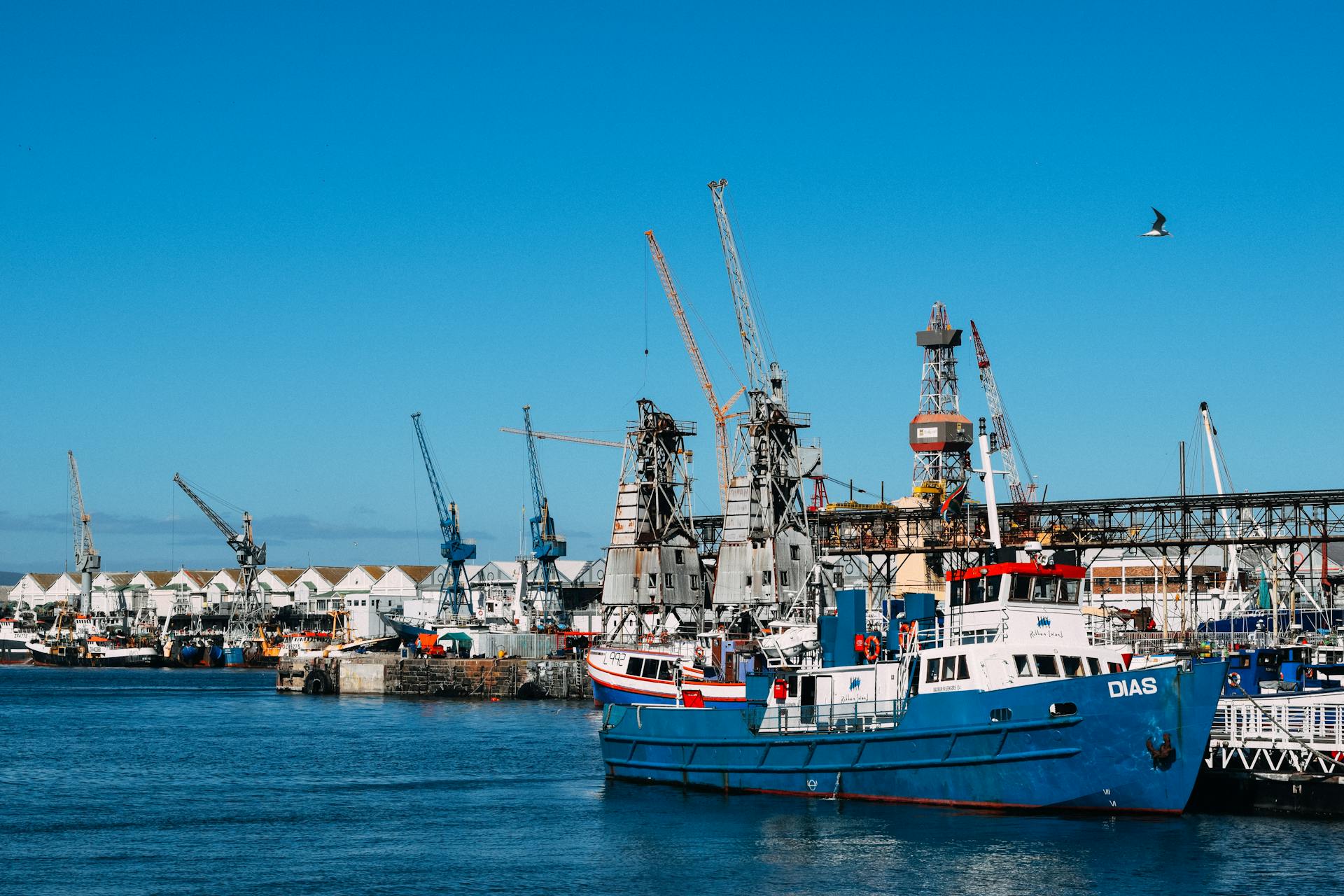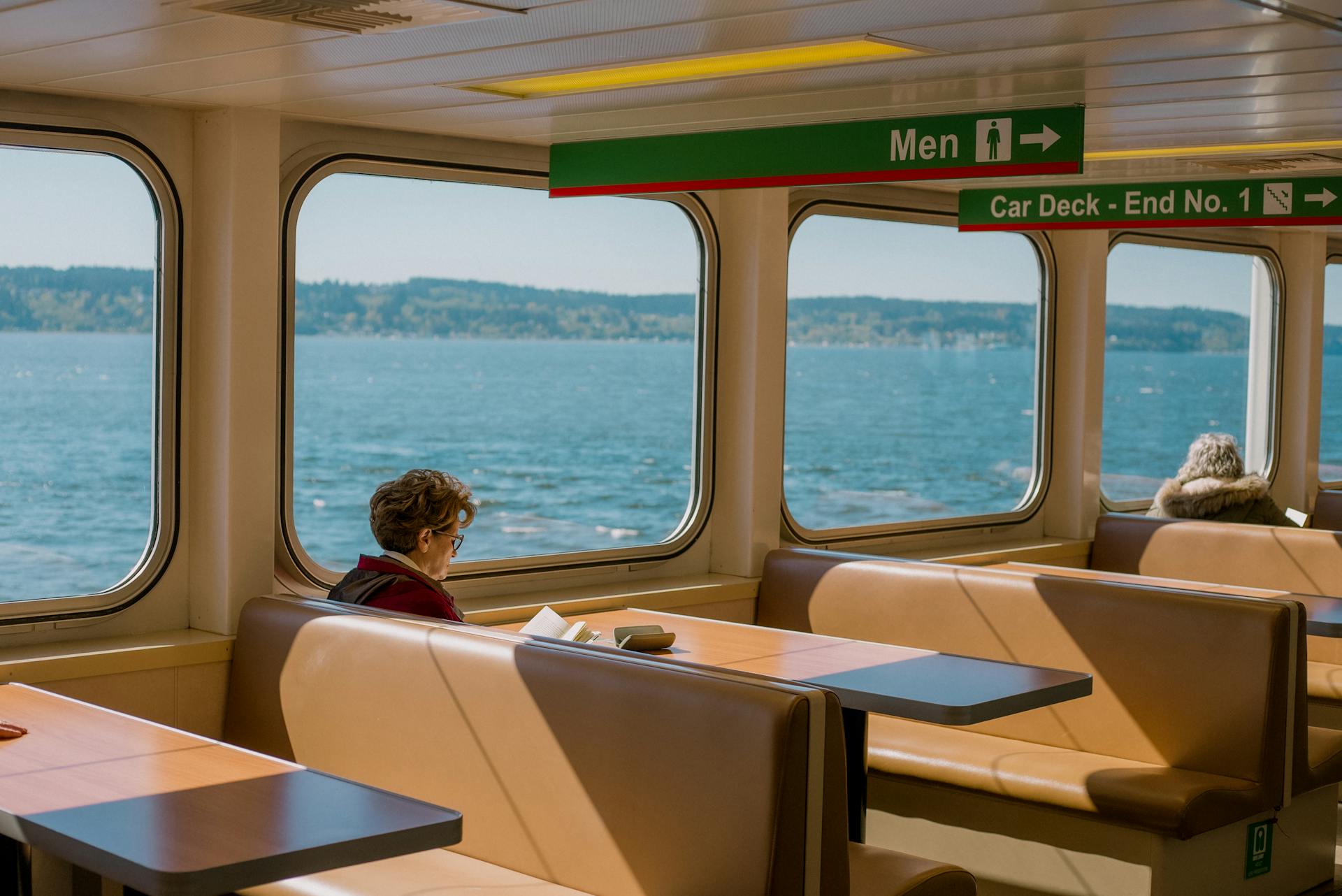
Ship mortgage is a type of financing used by shipowners to acquire or refinance a vessel. It's a complex process, but understanding the basics can help you navigate the international finance landscape.
Ship mortgage involves securing a loan with a ship as collateral, allowing lenders to repossess the vessel if payments aren't made. This makes it a high-risk, high-reward investment for lenders.
International ship finance is a multi-billion-dollar industry, with many countries participating in ship mortgage transactions. The global shipping industry relies heavily on international financing to acquire and operate vessels.
To get a ship mortgage, you'll need to provide a detailed business plan, financial statements, and a valuation of the vessel. A reputable ship mortgage broker can help guide you through this process.
You might like: Mortgage Broker Process
What is a Ship Mortgage
A ship mortgage is a legal agreement where a shipowner borrows money from a lender using the ship as collateral.
The ship serves as security for the loan, and if the owner fails to repay the loan, the lender can take possession of the ship and sell it to recover the debt, similar to a mortgage on a house or other property.
A different take: Will Lender Accept If a Friend Gift Money Conventional Loan
The shipowner retains ownership of the ship and is free to use it, provided they don't do anything that could reduce its value as collateral for the loan.
The lender, or mortgagee, is not responsible for any third-party liabilities, and the shipowner still has control over the ship.
The ship mortgage is a crucial concept to understand for anyone working in the shipping industry, as it can help secure financing for vessel purchases and upgrades.
Types of Ship Mortgages
In the United Kingdom, statutory ship mortgages are governed by the Merchant Shipping Act 1894 and subsequent amendments.
There are two main types of ship mortgages: statutory and equitable. Statutory mortgages can only be applied to registered ships.
Statutory mortgages are recorded in the register of the ship's port of registry, as stated in the Merchant Shipping Act 1988.
Equitable mortgages, on the other hand, take effect as purely equitable mortgages and can be applied to unfinished vessels, foreign vessels, and others.
Only registered ships can be subject to statutory legal mortgages, according to the Merchant Shipping Act 1894.
You might enjoy: Merchant Cash Advance Attorney
Registration and Legal Process
Registration of a ship mortgage is essential for it to have legal effects. In the UK, this is governed by the Merchant Shipping Act 1894 and its subsequent amendments.
The registration process involves submitting the mortgage agreement to the registrar of the ship's port of registry. The registrar will then record the mortgage in the ship's register.
The registration process varies depending on the jurisdiction, but it generally involves filing the mortgage agreement with the ship registry or other relevant authority. In China, for example, the mortgagor and mortgagee must submit three major documents, including a written application signed by both parties, the original Ship Ownership Registration Certificate, and the contract of ship mortgage.
In the UK, only registered ships can be subject to statutory legal mortgages. Any other mortgage related to ships shall take effect as a purely equitable mortgage. This means that unregistered mortgages may not be recognized by the law.
Here's an interesting read: Commercial Mortgage Rates Uk
Here are the key steps involved in registering a ship mortgage in the UK:
- Submit the mortgage agreement to the registrar of the ship's port of registry
- The registrar will record the mortgage in the ship's register
- The registration process is governed by the Merchant Shipping Act 1894 and its subsequent amendments
- Only registered ships can be subject to statutory legal mortgages
Key Terms and Risks
Ship mortgage involves unique challenges that can impact the mortgagee's rights and recourse. Other creditors may have priority over the mortgagee in case of claims against the ship, potentially reducing the mortgagee's recourse.
Ships are mobile, which can lead to jurisdiction issues. This means that if the ship sails to a different country, it can be harder for the mortgagee to enforce their rights.
Sea perils such as damage or sinking can reduce the ship's value as security, making it a riskier investment for the mortgagee.
Here are some key risks to consider:
- Other claims: Creditors with priority may reduce the mortgagee's recourse.
- Jurisdiction issues: Ships can leave the jurisdiction, making it harder to enforce rights.
- Sea perils: Damage or sinking can reduce the ship's value as security.
- Competing mortgages: Later lenders may have priority over the initial mortgage lender.
Certificate and Priority
To register a mortgage on a ship, you'll need to consider the certificate and priority of the mortgage. A person wanting to vary the priority of a mortgage on a ship needs to send Maritime New Zealand's Registrar of Ships the correct documents.
The documents required are a Variation of Priority of Mortgages (form SR18) – two originals – and a fee of NZ$368.
To understand how transactions are registered, note that they are registered in the order in which they are received by the registrar. The approximate processing time for this is ten working days from receipt of the correctly completed documents and payment of the fee.
Certificate of Mortgage
A Certificate of Mortgage is a crucial document for shipowners who want to mortgage their vessel outside its country of registration. This document allows the mortgage to take place in a foreign country.
To obtain a Certificate of Mortgage, the shipowner can apply to the port's registrar where the ship is registered. This process enables the mortgage to be registered in a foreign country.
The Certificate of Mortgage is a special document that facilitates international mortgage transactions. It's an essential tool for shipowners who need to secure financing from lenders in other countries.
See what others are reading: Foreign Currency Mortgage

In China, the process of registering a mortgage involves submitting specific documents. These include a written application signed by both parties, the original Ship Ownership Registration Certificate, and the contract of ship mortgage.
Here are the key documents required for mortgage registration in China:
- Written application signed by both parties
- Original Ship Ownership Registration Certificate
- Contract of ship mortgage
These documents are essential for completing the mortgage registration process in China.
Variation of Priority
To vary the priority of a mortgage on a ship, you'll need to send Maritime New Zealand's Registrar of Ships two originals of a Variation of Priority of Mortgages (form SR18).
The required fee is NZ$368.
To proceed, you should submit your documents and payment, after which the registrar will process your transaction in the order they receive it.
Disputes and Jurisdiction
Disputes and Jurisdiction can be a complex issue in ship mortgage cases. The Admiralty Court has the authority to resolve any claims related to ship mortgages.
Originally, disputes were handled by the Courts of Chancery, but now the Admiralty Court takes over.
International Finance and Guide
International finance can seem daunting, but it doesn't have to be. Most countries offer similar mortgage agreements to the UK's Merchant Shipping Act, making it possible for international shipowners to borrow with their vessels as security.
This flexibility is a game-changer for ship financing, allowing it to be accessible globally, regardless of the ship's registration location.
Origins and Evolution
The concept of Bottomry has been around for centuries, with its roots in ancient maritime cultures. The Phoenicians and Greeks used it as a method of financing maritime expeditions.
In fact, Bottomry was used by Phoenicians and Greeks as a way to raise funds from investors, who would lend money to the ship's owners in exchange for a share of the profits.
As maritime trade expanded, so did the use of Bottomry. In medieval Europe, it was used to finance shipping transactions, with the loan secured by the ship and its cargo.
Explore further: Which Credit Score Is Used for Mortgage Loans
The interest rate was based on the risk involved in the journey, and the lender would only receive payment if the ship arrived safely at its destination. This made it a high-risk, high-reward investment.
The legal framework of Bottomry has evolved over the years, with ancient times having no laws governing it, and disputes settled by the parties involved. In medieval Europe, it was subject to the laws of the sea, enforced by maritime courts.
Today, Bottomry is governed by international maritime law, providing a framework for the use of maritime loans. This has made it a more secure and reliable option for shipping companies.
The use of Bottomry has played an important role in the growth of maritime trade, and it continues to be used by shipping companies today. It's a fascinating example of how financial concepts can evolve over time.
One of the most famous examples of Bottomry is the voyage of Christopher Columbus, who financed his expedition to the Americas using funds raised from investors through Bottomry.
Worth a look: External Risk
International Finance
International Finance is a vast and complex topic, but don't worry, I've got you covered. Most countries offer similar mortgage agreements, allowing international shipowners to borrow with their vessels as security on comparable terms.
This flexibility makes ship financing accessible globally, regardless of the ship's registration location. It's great news for shipowners who want to explore international finance options.
With the right knowledge, you can navigate the world of international finance with confidence. The UK's Merchant Shipping Act provides a good starting point, but it's not the only option available.
Frequently Asked Questions
What size boat requires a ship mortgage?
Boats over 26 feet require a First Preferred Ship's Mortgage for full lender protection. This is because a standard title is not sufficient for vessels of this size
What is a first preferred ship mortgage?
A first preferred ship mortgage is a type of maritime loan that secures the initial loan and any future advances or extensions. It ensures the lender's priority in case of default, but requires documentation and inspection before disbursements can be made.
Sources
- https://en.wikipedia.org/wiki/Ship_mortgage
- https://www.marinepublic.com/blogs/charter/525877-what-is-ship-mortgage-the-certificate-of-mortgage-process
- https://fastercapital.com/content/Ship-mortgages--Exploring-the-Waters-of-Bottomry.html
- https://www.maritimenz.govt.nz/commercial/ships/ship-registration/part-a-ship-registration/ship-mortgages/
- https://sites.google.com/site/vesseldocumentationusa/understanding-the-preferred-ship-mortgage
Featured Images: pexels.com


